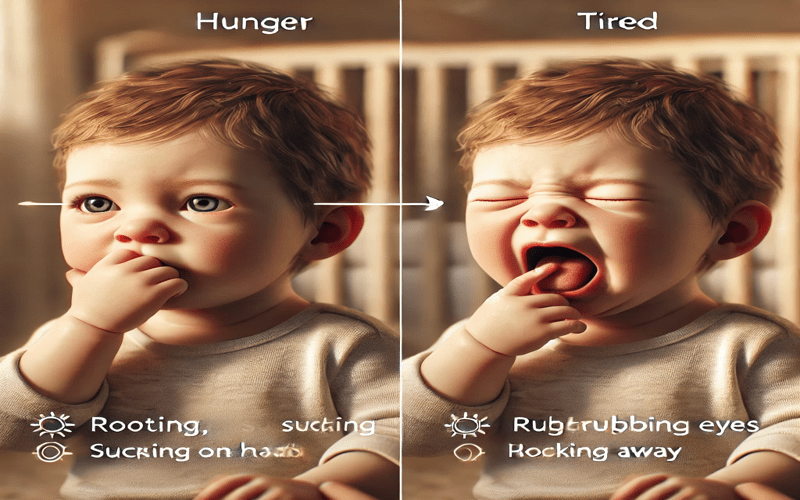
1.Introduction
Babies communicate through subtle signals, and distinguishing newborn hunger cues vs tired cues is key to meeting their needs effectively. Misreading these cues can lead to fussiness, making feeding or sleep routines challenging. Early signs, like rooting for food or yawning for sleep, help parents respond before distress escalates. By learning these cues, you can create a smoother routine, ensuring your baby stays well-fed, well-rested, and content.
2.Understanding Newborn Hunger Cues
Babies communicate their needs through signals, and recognizing newborn hunger cues vs tired cues helps you respond appropriately before they become overly upset.
Early Hunger Cues (Mild Hunger): Your baby may show subtle signs like opening and smacking lips, sticking out the tongue, or turning their head side to side (rooting reflex). These cues indicate they are ready to eat and should be fed soon.
Mid Hunger Cues (Moderate Hunger): If early signs are missed, your baby may start sucking on fingers, hands, or clothing, moving more actively, and showing light fussiness or whimpering. This means hunger is increasing, and they need to be fed quickly.
Late Hunger Cues (Severe Hunger): If the need for food is not met, your baby may become very upset, leading to intense crying, loud wailing, stiffening of the body, or clenching fists. At this stage, calming them before feeding may be necessary as frustration can make latching difficult.
Recognizing and responding to newborn hunger cues vs tired cues early can make feedings smoother, prevent fussiness, and support a healthy routine. Whether breastfeeding or bottle-feeding, understanding these signals helps keep your baby comfortable and well-fed.
If your baby seems fussy even after feeding or sleeping, checking their newborn sleeping head position can also help improve their comfort and rest.
3.Recognizing Newborn Tired Cues
Understanding newborn hunger cues vs tired cues is essential for ensuring your baby gets enough rest before becoming overtired. Babies often show clear signals when they are ready to sleep or need feeding, and identifying them early can make naps, bedtime, and feedings much easier.
Early Tired Cues (Mild Sleepiness): Your baby may begin rubbing their eyes, pulling their ears, yawning frequently, or losing focus by looking away. These gentle signs indicate it’s time to prepare for sleep.
Mid Tired Cues (Moderate Sleepiness): If early cues are missed, your baby may show increased body movements, jerky motions, fussiness, mild whining, or clumsy hand movements like scratching their face. This means they are getting sleepier and need to be soothed quickly.
Late Tired Cues (Severe Overtiredness): If not put to sleep in time, your newborn may become extremely fussy, crying intensely, showing stiff or restless movements, and struggling to fall asleep even when held. At this stage, recognizing newborn hunger cues vs tired cues is crucial, as misinterpreting them can make calming your baby even more challenging before sleep.
Recognizing these newborn hunger cues vs tired cues early can help prevent overtiredness, making it easier for your baby to fall asleep peacefully. Establishing a consistent sleep routine and responding to these signals on time will promote healthier sleep habits and a happier baby.
4.Key Differences Between Hunger and Tired Cues
Here’s a clear table highlighting the key differences between newborn hunger cues vs tired cues:
| Hunger Cues | Tired Cues |
|---|
| Rooting and sucking | Rubbing eyes and yawning |
| Hand-to-mouth movements | Looking away and losing focus |
| Increasing fussiness | Body stiffness and jerky movements |
| Calms down after feeding | Still fussy after feeding but settles with sleep |
Recognizing these newborn hunger cues vs tired cues early helps parents respond appropriately, ensuring their baby is well-fed and well-rested.
5.How to Respond to Your Baby’s Cues Effectively
Understanding your baby’s signals is key to meeting their needs before they become too fussy. Here’s how you can respond effectively:
Watch for early signs: Identifying your baby’s signals early makes feeding and sleep smoother.
Avoid waiting for extreme cues: Crying makes it harder for babies to settle, whether they are hungry or sleepy.
Establish a routine: A consistent schedule for feeding and naps helps reduce fussiness and promotes better sleep.
Observe patterns: Every baby is different. Noticing their unique behaviors will help you respond appropriately.
By recognizing your baby’s signals early and understanding newborn hunger cues vs tired cues, you can respond with care and create a more peaceful routine for both you and your little one.
6.Common Mistakes Parents Make
New parents often misinterpret their baby’s signals, which can lead to unnecessary fussiness and frustration. Here are some common mistakes to avoid:
Confusing hunger with tiredness: Sometimes, a baby who is overtired may be mistaken for being hungry. Instead of feeding, helping them settle for sleep may be the right solution.
Waiting too long to respond: Ignoring early signals can make babies more distressed, leading to intense crying and making it harder to soothe them.
Not following a routine: Inconsistent feeding and sleep schedules can make it challenging to recognize patterns, making it harder to meet your baby’s needs in a timely manner.
By being observant and recognizing newborn hunger cues vs tired cues early, parents can create a calmer environment and ensure their baby is well-rested and properly fed.
7.Understanding Your Baby’s Unique Signals
Every baby communicates differently when it comes to newborn hunger cues vs tired cues. While some babies give subtle hints, others express their needs more clearly. Parents often rely on general cues, but it’s essential to recognize your baby’s individual patterns. Observing their specific reactions to hunger or sleep will help you respond more effectively. Understanding newborn hunger cues vs tired cues ensures that your baby gets the right care at the right time, making feeding and sleep routines smoother and more comfortable.
Conclusion
Recognizing newborn hunger cues vs tired cues helps parents respond effectively, reducing fussiness. Watching for early signs prevents distress, making feeding and sleep routines smoother. Avoid waiting for extreme signals, as an overtired or overly hungry baby is harder to soothe. Establishing a routine and observing unique patterns will help you meet your baby’s needs with confidence. A calm, well-fed, and well-rested baby leads to a happier and more peaceful parenting experience.
FAQS
How do I know if my newborn is tired or hungry?
Newborns show different cues for hunger and tiredness. Hunger cues include rooting, sucking on hands, and increasing fussiness. Tired cues involve rubbing eyes, yawning, losing focus, and jerky movements. Observing these signals early helps you respond appropriately.
2. Can sleepy cues look like hunger cues?
Yes, some sleepy cues (such as sucking on hands or fussiness) can resemble hunger cues. If your baby recently fed and is showing these signs, they may be tired instead of hungry.
3. What are tired cues for newborns?
Newborn tired cues include yawning, rubbing eyes, pulling ears, looking away, fussiness, and jerky body movements. Responding early can help prevent overtiredness.
4. How to tell the difference between hunger cues and self-soothing?
Babies often suck on their hands as a natural reflex, which can indicate both hunger and self-soothing. If your baby has been recently fed and appears calm, they are likely trying to comfort themselves. However, if they seem restless, rooting, or becoming fussy, it’s a strong sign they are hungry and need to be fed soon. Observing other cues, like body movements and facial expressions, can help determine whether your baby is hungry or just self-soothing.
